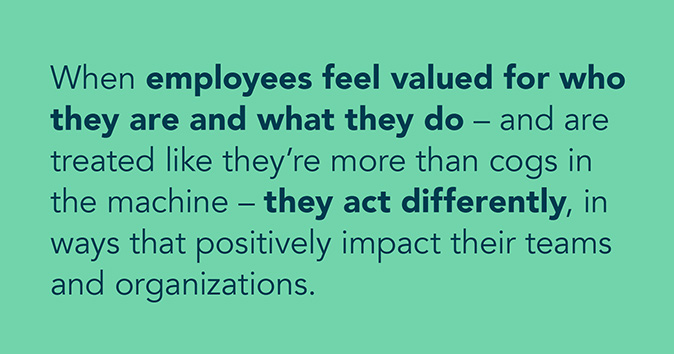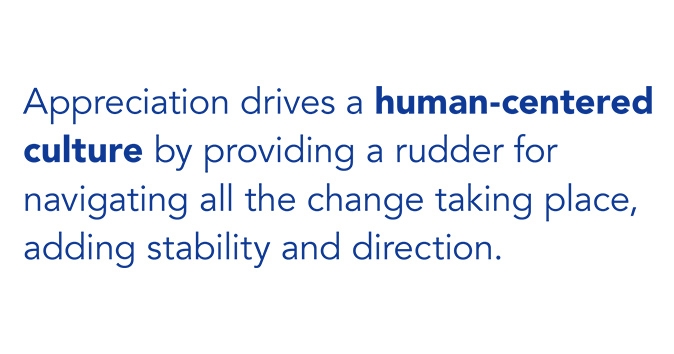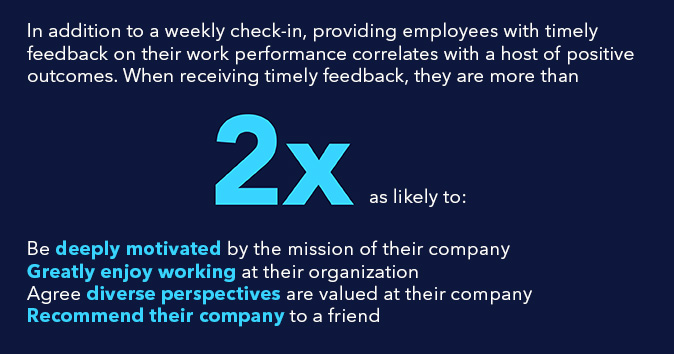Analyzing the Difference Between Recognition and Appreciation For a Thriving Workplace

You’re at work, and your manager sends you a gift card for a job well done. That’s recognition. Now, imagine your colleague messaging you a “thank you” for brightening the mood during a stressful week. That’s appreciation.
Although the terms “recognition” and “appreciation” are often used interchangeably in the workplace, they serve different purposes and are given for different reasons. While recognition focuses on what employees do, appreciation emphasizes who they are.
Striking a balance between the two creates a positive employee experience, nurtures a healthy company culture, and leads to better business outcomes.
Download our exclusive report to learn how strategic employee recognition can benefit your organization. Here's what you'll discover in this must-read report:
1. The impact of recognition on business outcomes, including increased productivity, safer workplaces, and decreased absenteeism.
2. Strategies for implementing a recognition program that is fulfilling, authentic, equitable, embedded in company culture, and personalized to the individual.
3. Save your organization more than $90 million in gained employee productivity. Invest in your employees and your business success by embracing strategic recognition.
In this article, we’ll take a closer look at the difference between recognition and appreciation and learn how organizations can harness both.
What is recognition?
Employee recognition is the act of acknowledging, thanking, and praising staff for their contributions, both formally and informally. Recognition primarily centers around specific accomplishments, achievements, or outstanding performance.
Formal recognition usually comes in the form of bonuses, promotions, pay raises, or awards in an employee recognition program. It’s appropriate to give formal recognition for service milestones or work that is tied to a company goal or value.
Informal recognition, like a shout-out at the beginning of a meeting, is often used when recognizing daily contributions or to acknowledge a specific behavior, like when there is improved performance.

Key benefits of recognition
It’s nearly impossible to find an area that recognition doesn’t positively affect. Recognition boosts employee engagement and wellbeing, helps build a strong workplace culture, reduces turnover, improves safety, and provides a better customer experience.
The data underscores the importance of recognition. Our research with Gallup has found that when employees are receiving the right amount of recognition, they are:
- Four times more likely to be engaged
- 44% more likely to be “thriving” in their life overall
For more information on how a culture of recognition can amplifying the wellbeing of your employees, check out this Workhuman-Gallup report :
- 30% less likely to experience burnout than those who do not believe they are getting the right amount of recognition.
- 56% less likely to seek out new job opportunities
Find out how Recognition data can take your DEI strategy to new heights.
Common forms of recognition at work
- Monetary bonuses and incentives like gift cards or salary or pay increases
- Offering a social recognition program that supports peer-to-peer recognition
- Employee of the Month awards
- Celebrating service milestones like work anniversaries and congratulatory promotion announcements
- Written or verbal praise for high performance
What is appreciation?
Employee appreciation is defined as the act of recognizing and rewarding employee contributions to the workplace, either through formal or informal channels.
Appreciation differs from recognition because it is about acknowledging a person’s inherent value. It goes beyond results and recognizes the individual as a whole, appreciating their unique qualities and contributions. In practice, this looks like showing appreciation or gratitude for someone’s positive attitude, teamwork, or consistent effort, regardless of specific outcomes.

Key benefits of appreciation
Employee appreciation is a powerful tool that strengthens teams, infuses work with meaning, and aligns employees toward a shared purpose that motivates them to perform at their best. Here are a few more benefits that highlight the importance of appreciation:
- A culture of appreciation fosters a sense of psychological safety. Employees who feel valued are more likely to speak up, share concerns, and contribute to a safer work environment.
Download our exclusive report to discover how to create an environment that takes the safety of all employees into account.
- Employees that feel appreciated are more engaged and committed. As a result, employees want to come to work, leading to increased creativity and innovation and continuity in work.
- Regular appreciation acts as a buffer against burnout. Gratitude helps employees weather out-of-their-control challenges, such as market shifts or mergers, by reinforcing their connection to their colleagues and their work.
Attention leaders! Do you want to improve employee wellbeing and drive business success? Discover how strategic recognition can help in the Workhuman and Gallup report:
- Amplifying Wellbeing at Work and Beyond Through the Power of Recognition.
- Learn how recognition can improve engagement, reduce burnout, and increase company loyalty, resulting in clear ROI.
- The report examines a large-scale study of over 12,000 employees across 12 countries and uncovers the connection between recognition and wellbeing in each region.
Take action to improve employee wellbeing today!
How to show appreciation at work
- Express your appreciation verbally, whether it’s in person, during a team meeting, or through a phone call. Be specific about what you’re thankful for.
- Take the time to send a meaningful message through email, Slack, or in the chat of a video call. Sending a colleague a handwritten note adds a special touch.
- Recognize your colleagues publicly. Share their achievements during team meetings, in newsletters, or on social media platforms. Public praise boosts morale and motivates others.
- Small acts of kindness matter. Bring in treats for the team, offer to help with a task, or surprise a coworker with their favorite coffee.
- Celebrate milestones like a birthday, Employee Appreciation Day, or a major life event by organizing a virtual celebration, decorating their workspace, or giving them a personalized gift.
- Be supportive during challenging times. Offer words of encouragement, lend a helping hand, or provide emotional support.
- Appreciate the effort put into a project, even if the outcome isn’t perfect. Recognizing efforts, and not just results acknowledges hard work, dedication, and resilience.
- Organizations can offer a range of professional development opportunities like training, workshops, and skill development to show employees that they’re invested in their growth.
Understanding the difference between recognition and appreciation
Put simply, recognition highlights accomplishments, while appreciation conveys gratitude for who someone is as a person. Let’s look at the key differences between the two:
Employee Recognition
Focus: Acknowledges specific accomplishments or outstanding performance.
Purpose: Highlights work-related efforts and results.
Examples: Recognizing achievements like meeting project deadlines or exceeding sales targets.
Emphasis: Achievement-oriented.
Employee Appreciation
Focus: Acknowledges a person’s inherent value beyond specific outcomes.
Purpose: Recognizes the individual as a whole, appreciating their unique qualities and contributions.
Examples: Showing gratitude for positive attitudes, consistent effort, or teamwork.
Emphasis: People-oriented and holistic.
Balancing employee recognition and appreciation strategies
If you’ve made it this far, you’re already off to a good start. Understanding the difference between appreciation and recognition is the first step in creating a balance between your strategies. The rest comes down to not emphasizing one over the other and seeking out ways to connect praise to the organization and the individual.
Align strategies with company goals and values
When recognition and appreciation align with company values, they reinforce the desired behaviors and values. Employees will feel encouraged to repeat the behaviors that earn them praise and embrace the aspects of their personalities that garner appreciation. Most importantly, employees will feel comfortable showing up as their authentic self at work.
Tying appreciation and recognition to values and goals ensures employees experience a consistent message about what behaviors and contributions are valued. Additionally, recognition tied to company goals motivates employees to work toward shared objectives.
When these strategies resonate with the DNA of the organization, they reinforce the desired culture, motivate employees, and drive performance. It ensures a harmonious environment where everyone contributes meaningfully to the company’s success.
Embrace structure and impromptu moments
Implement a formal peer-to-peer social recognition program into your organization’s culture and consistently educate employees on the program so that it’s accessible and easy to use. Utilize this program to celebrate big wins, employee milestones, and life celebrations. But don’t stop there – find ways to weave appreciation into the day-to-day of your workplace culture.
Learn how Social Recognition® can transform the culture and employee experience at your organization.
To do this, start at the top. Encourage senior leaders to publicly appreciate senior management or their direct reports for what they bring to the organization. Modeling this behavior shows that thanking and noticing others for who they are is part of the organization’s DNA and will start a positive chain of gratitude.
Ensure shout-outs are personal and meaningful
Tailor recognition and appreciation of individual preferences. Some may value public recognition, while others prefer private gestures. Understanding individual needs strengthens the impact.
For example, there are employees who prefer written messages that they can revisit during a tough week, while others might be energized by shout-outs during quarterly meetings.
Regularly gather feedback from employees on their preferred recognition and appreciation methods. This helps tailor strategies to their specific needs and values, leading to more meaningful appreciation and positive feedback.

Conclusion
Employee recognition and appreciation isn’t just about saying “thank you.” It’s about creating a fulfilling, authentic, and integrated experience that positively impacts both individuals and the business.
As we’ve learned, the difference between recognition and appreciation leaves organizations and employees with an assortment of ways to show gratitude to a team member. Who will you appreciate or recognize today?
About the author
Alicyn Zall
Alicyn Zall is a writer dedicated to creating a more equitable and fulfilling workplace. With a focus on actionable, data-driven insights, her work empowers individuals and organizations to foster positive change. In addition to her contribution at Workhuman, Alicyn has served as an editor at Harvard Business Review where she developed books and articles about mental health and the future of work.